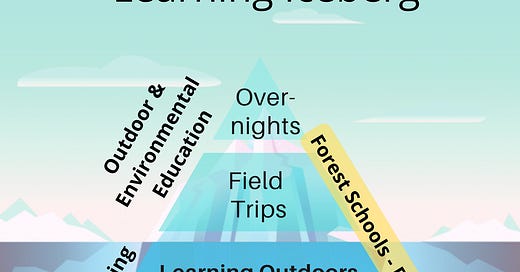Dear you,
I got your message. My letters are too long (verbose!) for the attention economy. Fine. I’ll be more succinct (just cut two words out of the previous sentence, which I’m now undermining, but I digress…). I’ll use fewer words and I'll send more letters. (What do you think about that Ben Katz?)
I wanted to tell you something that has happened organically as I’ve talked about “the pyramid” (Maslow’s Hierarchy of Nature-Connected Learning). Nature metaphors have emerged.
Today’s is an iceberg.
The USGS says 90% of an iceberg is underwater! I believe 90% of nature-connection can happen in schools using nature-based learning (that still leaves 10% for the rad and transformational top-of-the pyramid iceberg days-and-nights-under-skies-capital-N Nature experiences I wrote about here).
Being underwater, nature-based learning hasn’t gotten much sunlight. And it is the exception - relegated mostly to a few folks who are also doing tip-of-the-iceberg awesomeness. In Richard Louv’s international best-seller, Last Child in the Woods, he wrote,
Most current progress in education…comes from iconoclastic individuals.” (p211 in the 2008 edition)
I’m grateful for iconoclasts who have adopted nature-based learning. Unfortunately, it’s far from bread and butter practice. Plus, sometimes the iconoclasts are so awesome they make things seem out-of-reach for the rest of us! So, I’m trying to surface (like what I did there?) these below-the-water-line, super-simple, attainable, low-cost, low-risk, high-reward, actionable, equity-oriented innovations that ANY EDUCATOR ANYWHERE can implement immediately.
I want nature-based learning to be mainstream.
I can’t take credit for this mainstreaming goal. I actually found it in the growing body of evidence documenting nature’s benefits for humans – and especially for learners. A 2019 integrative mini-review funded by the National Science Foundation1 summarized the research regarding nature’s impacts on learning and learners. The researchers conclude: “Nature should be integrated into formal education as a mainstream teaching and learning resource.”
YES!
Here’s how: build educators’ capacity to teach student outdoors in nearby nature or to bring elements of nature indoors for learning. (Note: this is what Good Natured Learning does.)
Ok, that’s all for now. Next up: the pyramid as a mountain!
Did this pass the attention economy test? Be real with me in the comments section (and offer any other thoughts you have about this stuff while you’re at it).
Hugs,
Becca
PS - Please write back (did I mention the comments section below?)
PPS - Please share with 1 person who should be reading it!




